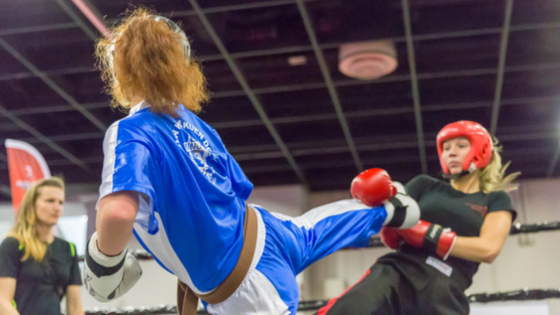Can curriculums and lesson plans be too structured?
The question might seem absurd. In the old days, instructors would teach random techniques without rhyme or reason, making it difficult to learn a system and dramatically slowing progress toward mastery. So when structured curriculums came along, martial arts instruction was revolutionized and learners unquestionably benefited.
But with structure comes another danger. Jia Yi Chow, et al. (2016) pose an interesting question to martial arts instructors:
[C]oaches have a responsibility to ensure that their performers are prepared for anything that the environment or the task can throw at them. For example…[h]ow would a tae kwon do performer cope if a new opponent appeared on the scene who was taller, stronger and faster? (Nonlinear Pedagogy in Skill Acquisition, p. 153)
A typical response to this problem would be to script drills in response to anticipated attacks. But the flaw in this method quickly presents itself: since a real, live opponent is unpredictable, it’s impossible to account for all potential attacks this way.
If you can’t memorize individual responses to every conceivable attack that might come your way, how then do you prepare for fighting unknown, unpredictable opponents?
The answer is a concept known as variable practice.
How Variable Practice Works
Variability boils down to unpredictable changes in the practice environment and tasks you perform during practice. The goal of variability in practice is to build a learner’s ability to adapt to unstable circumstances, like a fight.
Practice variability exists at more than one level. At the activity level, opponents kick, punch, and grapple in unscripted sequences that are hard to predict. At the session level, variability would be changing partners every round of sparring or shifting between different learning activities within the same class.
Most of you are familiar with these exercises, but hear me out. I’m not arguing that you should include them (since you already have most likely) but that you should use them more often. As in, a part of every class.
In fact, I want to suggest something many of you might find controversial:
Both activity- and session-level variability should dictate nearly every aspect of your classes.
That means any drills or exercises that are scripted or cooperative should be minimized, and unscripted, uncooperative exercises should be emphasized. Yes, that even means spending more time in “live” drills than putting in technique reps.
I know this is contentious — even among “functional” martial artists like jiu-jitsu instructors — but hear me out again…
Variability Is Superior to Repetition, Research Says
Our human tendency to organize our endeavors into neat sequences feels like it’s always better than a less structured approach to teaching (it’s certainly better than no structure). But the science of motor learning tells a very different story.
Herbert, Landin, and Fairweather (1993) conducted a research study on basketball training methods. Study participants were placed into two separate groups: one where they engaged in blocked practice and one where they engaged in random practice.
Blocked practice involves repeating the same techniques over and over again from the same position and angle every repetition. In this case, shooting free throws from the same position with the same movement pattern. Random practice involves changes to the position, angle, and task every repetition. In this case, shooting at different positions and distances from the hoop.
The results of the study were counterintuitive:
Although the blocked training group showed greater improvement during practice, the retention of those skills at later practices was poor. Conversely, the random practice group showed little improvement during practice but greater skill at later practice as well as much stronger retention of those skills.
Herbert, et al. conclude:
The results indicate that performance on initial trials of a retention test was better following variable rather than specific practice. This suggests that a variable practice schedule, which includes criterion skill, may be better than blocked practice. (The effects of variable practice on the performance of a basketball skill, p. 336)
Traditionally, coaches in the martial arts and sports in general rely heavily on trying to perfect technique through blocked practice. They shy away from random practice until mastery is consistently demonstrated through blocked methods.
There’s a seductive temptation here — another reason why coaches tend to shy away from variable practice methods. Because traditional blocked practice shows improvements that instructors can observe during practice, it seems like it’s working better than a randomized or variable lesson approach (even though retention is terrible).
In contrast, variable practice looks messier and often shows no observable improvements during immediate practice. But it pays off in later practices with dramatically increased retention and overall better-developed skills. It takes longer to see results, but it’s significantly more effective training for your students.
Variable Practice Builds a Greater Ability to Handle Any Situation
In their study, Variability of practice and implicit motor learning (1997), Gabriele Wulf and Richard Schmidt found that in an exercise where participants had to visually track targets on a screen,
increasing the variability (in terms of the absolute amplitude or time scaling) of the middle segment during acquisition facilitated performance on the repeated segment, relative to constant practice, and the beneficial effects of practice variability were independent of the type of variability (i.e., whether this variability was in the absolute movement amplitudes or in overall movement durations). These effects were seen during the acquisition, retention, and transfer phases, and even during the random test. Of importance, the variable groups outperformed the constant groups in the retention test, even though the constant groups had a specificity advantage over the variable groups in the retention test…Also, in transfer, errors on the repeated segment were smaller for the variable groups than for the constant subgroups that had practiced scalings of the repeated segment closest to those required in transfer, whereas the variable groups had experienced these scalings only on one third of their practice trials. The important point is that the advantages from the repeated segment do not simply arise from having identical experiences from the repetitions that somehow accumulate over the acquisition trials.
Variability not only facilitated performance on the repeated segments, but it facilitated the learning of the tracking task generally. Again, these effects were independent of the type of practice variability. (emphasis added)
In other words, variable practice doesn’t just help you with the skill at hand — it helps train a more general skill to handle novel situations more effectively. Obviously, this is invaluable to martial artists, whether they’re ring fighters or just want to defend themselves, because they cannot anticipate the unique threats each opponent poses them.
Conclusion
Structure has raised the effectiveness of martial arts training but has also led to practice designs that hinder the natural human learning process. Though logical, well-structured lesson plans feel most effective, motor learning research indicates that a lack of randomness or variability is less effective for building motor skills.
Researchers have found that, while blocked practice methods yield noticeable improvements during practice, variable practice methods yield far greater skill gains and retention overall. Unfortunately, because variable practices don’t produce immediate, visible improvements in learners, coaches are traditionally more likely to avoid it for blocked practice methods.
However, since martial arts largely deals with unpredictable opponents in both sport and self-defense contexts, instructors should prepare their students to meet these threats by embracing a variable practice design in all of their lesson plans.
Here at Gymdesk, we have several features that can help you track the skill progression of your martial arts students. To find out more on how our software helps enhance martial arts schools, check out our Gymdesk martial arts page.
 39 Martial Arts Statistics To Know in 2022
39 Martial Arts Statistics To Know in 2022



